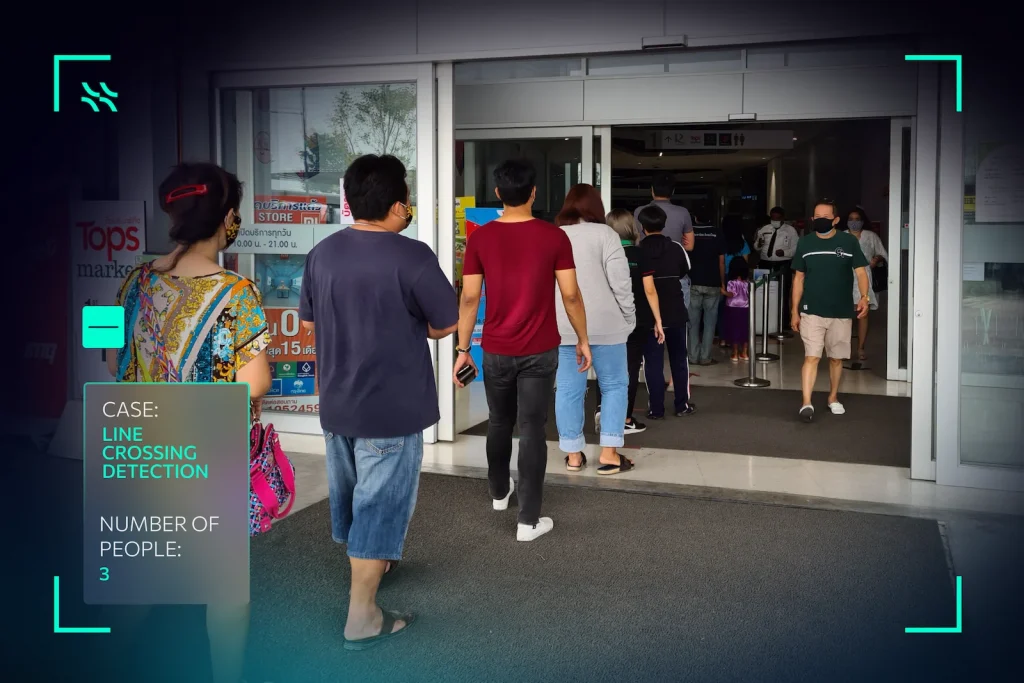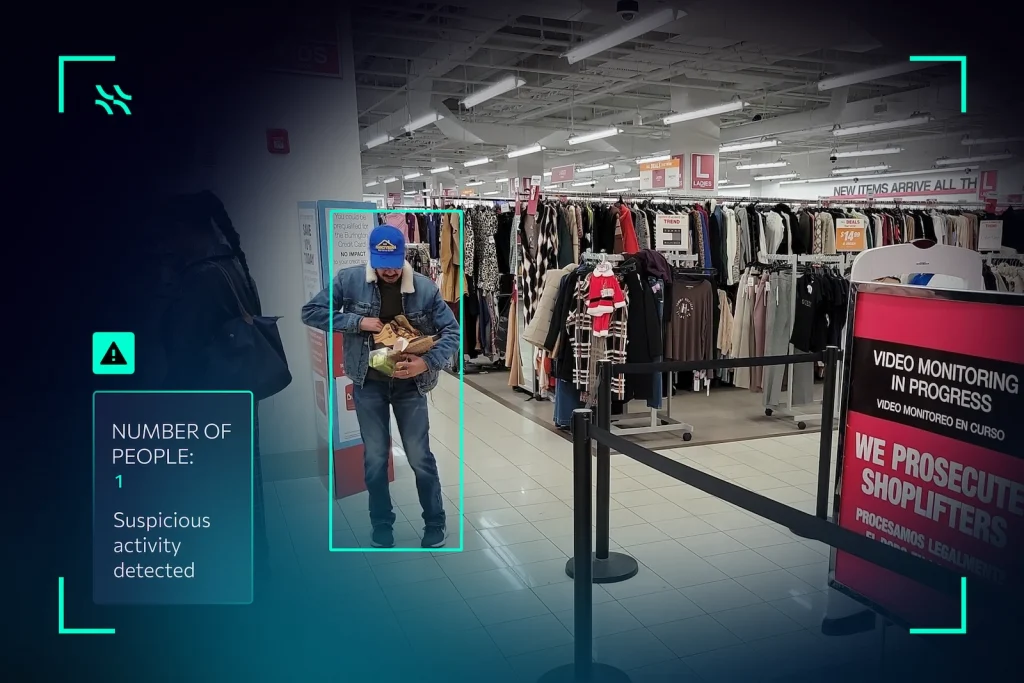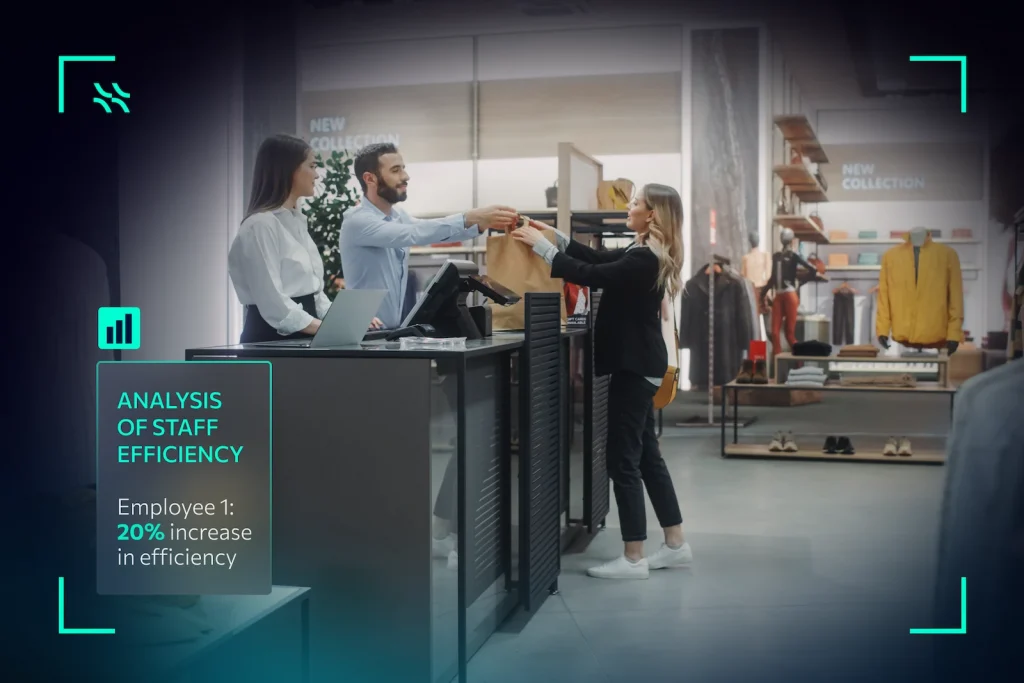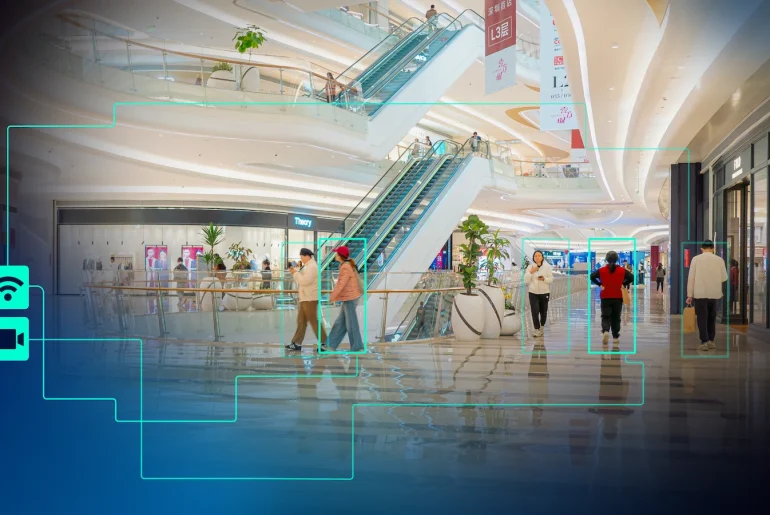Building a Smart Retail Mall Infrastructure with Video Surveillance, Video Analytics, and Integrated Security Systems
Case Study Video Surveillance. Overview
In the retail industry, especially during peak hours, maintaining a secure, well-organized environment can be a significant challenge. This case study outlines how a telecom provider in Europe offered a comprehensive cloud-based video surveillance as a service (VSaaS) solution to a large retail mall chain in one popular touristic city, addressing common operational problems and enhancing security through cutting-edge technologies: video surveillance, AI-powered video analytics, access management, and public Wi-Fi.
Go below to explore all the details of case study video surveillance!
Case Study Video Surveillance. Problem
The retail mall faced several operational hurdles during weekends, holidays, and sales seasons, with a marked increase in foot traffic. Key challenges included:
1. Safety Concerns
Statistics says – A report by Software Advice examined retail security and loss prevention, highlighting that 68% of SMB retailers face shrink rates exceeding the industry benchmark of 1.5%. This increase is largely driven by external theft, including shoplifting, organized retail crime, and fraudulent returns, posing a significant challenge for businesses with tighter profit margins and less advanced loss prevention methods. To combat shrink, many SMB retailers are implementing various strategies. Notably, 54% have installed or upgraded security cameras in the past year, reflecting their dedication to enhancing surveillance and minimizing theft.
- Overcrowding Risks. During peak hours, the mall frequently experienced unsafe crowd densities in specific areas, such as entrances, food courts, and popular stores. These conditions increased the likelihood of accidents, such as trips, falls, and health emergencies. It posed a compliance risk regarding safety regulations.
- Fire and Hazard Detection. Fire safety systems were largely reactive, relying on manual interventions and delayed alarm systems, which prolonged response times and put both customers and staff at risk during emergencies.
- Emergency Coordination. In the event of an evacuation or medical emergency, the lack of cohesive communication and real-time situational awareness made coordination between security teams and mall management inefficient.
2. Operational Challenges
- Theft and Shrinkage. The sprawling size of the mall and the concentration of high-value merchandise in various stores created opportunities for theft. Security teams struggled to identify and deter shoplifting without constantly patrolling or intrusively monitoring customers.
- Customer Flow Management. Bottlenecks frequently occurred in high-traffic areas such as checkout counters, escalators, and store aisles. Inefficient crowd flow often caused customer frustration, especially during promotional events and holiday rushes.
- Queue Inefficiencies. Long lines at checkout counters reduced customer satisfaction and led to lost sales, as impatient shoppers abandoned their carts or left without completing their purchases.
- Staff Deployment Issues. Without accurate data on peak traffic times and high-density areas, mall management struggled to position staff effectively, often leading to understaffing during busy periods and overstaffing during quieter hours.
3. Analytics Limitations
- Lack of Behavioral Insights. Mall operators had no data on how customers interacted with spaces, including popular store layouts, frequently visited sections, or preferred shopping routes. This lack of visibility hindered their ability to improve customer experiences or optimize tenant performance.
- No Traffic Forecasting. Management lacked tools to predict peak periods based on historical patterns, weather conditions, or local events, making it harder to prepare for surges in visitors.
- Limited Tenant Feedback. Retailers within the mall were unable to provide clear insights into customer demographics or behavior, affecting their ability to adjust product placements, promotions, and inventory.
4. Marketing Gaps
- Missed Promotional Opportunities. The mall couldn’t measure the effectiveness of marketing campaigns, such as discounts, flash sales, or events, due to the absence of tools for tracking customer engagement and movement.
- Lack of Personalized Engagement. Without digital tools to engage shoppers in real-time, the mall missed opportunities to promote loyalty programs or send personalized offers based on customer preferences and locations.
- Tenant Revenue Maximization. Without detailed analytics, the mall struggled to justify premium leasing costs to retailers based on customer flow data, impacting long-term revenue potential.
5. Management Inefficiencies
- Disjointed Oversight. Managing multiple locations or even different sections of a large mall became increasingly complex without a centralized system for monitoring and coordinating activities.
- Delayed Incident Responses. Security and management teams faced delays in responding to incidents due to a lack of real-time situational awareness.
- Costly Maintenance. Legacy systems required frequent repairs and manual oversight, increasing operational costs without offering modern functionality.
These persistent problems affected not only the mall’s operational efficiency but also customer satisfaction, tenant relations, and overall revenue potential. The retailer’s existing security infrastructure was outdated and lacked real-time analytics capabilities, making it difficult to respond to these issues efficiently.
Case Study Video Surveillance. Solution
To address these challenges, a telecom operator already providing fiber-optic infrastructure to the retailer’s distributed stores proposed a comprehensive turnkey solution with proven efficiency in many progressive countries. The cloud-based and scalable Aipix VAS platform became the ideal software solution for this project. Our VSaaS solution allowed for seamless switch from another surveillance provider. Telecom managed to offer retail business advanced video surveillance, access management systems, public Wi-Fi, fire detection, and advanced video analytics. All with rapid deployment and reliable tech support create an innovative and hassle-free smart retail environment for both telecom as a provider and shopping mall as a recipient.
Enhancing Retail Security and Operations with Advanced Video Surveillance Solutions
The implementation focused on high-traffic areas such as entrances, lines with high-value merchandise, and checkout counters. It included:
- Cloud-based video surveillance enables scalable, secure, and easily managed security across multiple store locations. By storing footage in the cloud, it eliminates the need for on-site hardware and allows centralized, remote monitoring. This solution reduces maintenance costs, provides real-time access to video feeds, and can easily scale as the store network grows, with high security and encryption for sensitive data.
- AI-powered video analytics provides real-time insights into customer behavior, detects shoplifting, and helps manage crowd flow. By analyzing video feeds, it identifies patterns like suspicious activity and overcrowding, allowing for prompt responses. This technology enhances security, improves operational efficiency, and helps optimize the customer experience.
- Access management monitors and controls entry points within the mall, ensuring safety and regulating crowd density. It helps prevent unauthorized access, manage foot traffic, and maintain safe occupancy levels in high-traffic areas, enhancing overall security and compliance.
- Public Wi-Fi provides secure internet access to customers. This enhances the shopping experience and supports data-driven insights for mall management and marketing activities.
- Fire detection to enhance safety through real-time alerts in case of fire hazards.
The telecom operator, in partnership with equipment providers and Aipix software solutions, managed all aspects of the system, from setup to ongoing support. This collaboration ensured the transition to the advanced solution was both cost-effective and time-efficient. All of them leveraged the expertise of each partner to deliver a seamless, integrated security and operational platform.
Key Features & Benefits
Customer Traffic Analysis

Description
Real-time tracking of customer flow into and out of the store helps identify peak hours, enabling better crowd management.
Key Benefit
This allows for optimized staffing, minimizing overcrowding and enhancing the overall customer shopping experience.
Queue Management
Description
Monitors checkout line wait times and notifies staff when queues exceed predefined thresholds, helping manage customer flow at the point of sale.
Key Benefit
Reduces customer frustration and prevents lost sales opportunities due to long wait times, ensuring smoother transactions.
Shoplifting Detection

Description
AI-powered algorithms analyze behavior patterns to detect suspicious activities, such as loitering near high-value items or repetitive movements in specific areas.
Key Benefit
This feature acts as a deterrent to theft, reducing financial losses by sending real-time alerts to security staff for swift intervention.
Pickpocket Prevention
Description
Behavioral analytics monitor unusual movements, particularly in crowded areas, focusing on personal belongings like bags and pockets.
Key Benefit
Enhances overall security, especially during busy shopping periods, and helps protect customers from pickpocketing.
Crowd Density Monitoring
Description
Real-time tracking of crowd density in various sections of the mall ensures that no area exceeds safe capacity levels.
Key Benefit
This feature ensures compliance with safety regulations, preventing overcrowding and minimizing safety hazards.
Staff Efficiency Analysis

Description
Monitors staff positioning and activities to ensure they are optimally placed during peak times for customer service and safety.
Key Benefit
Increases operational efficiency, improving staff productivity and enhancing the customer experience during busy hours.
Conclusion
The deployment of turnkey video surveillance solution based on Aipix software solution for the retail mall transformed the way the business operated, especially during heavy high-traffic periods. By integrating cloud-based video surveillance, AI-powered analytics, and comprehensive security systems, the retailer was able to:
- Enhance security and reduce theft-related losses (decrease in theft-related losses in 15%) .
- Improve crowd management and customer experience.
- Optimize operational efficiency, especially in staff allocation and queue management(2x better operational efficiency).
- Ensure safety with real-time alerts for fire detection and overcrowding.
Ultimately, the retailer achieved a safer, more organized environment, leading to higher customer satisfaction and an overall improvement in business operations. The success of this smart retail mall infrastructure highlights the critical role of video surveillance and analytics in modern retail, particularly for handling the challenges of peak shopping periods.
Want to find out about Aipix more? Visit our YouTube channel for more!
Interested in learning more about our expertise and capabilities? Contact us for a consultation to explore your needs and create a transformative solution.
Or leave request on free consultation:





